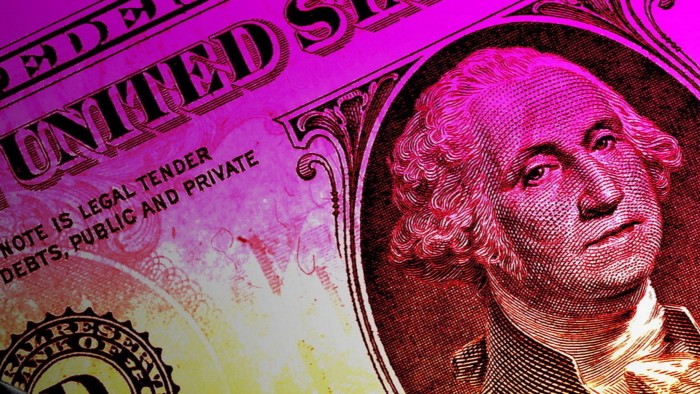Unlock the Editor’s Digest for free
Roula Khalaf, Editor of the FT, selects her favourite stories in this weekly newsletter.
The main reason I found Day of the Triffids terrifying as a boy was the realisation that I would have for sure been one of the first people to gawp skyward at the green meteor shower. The lights are so pretty! Oh, I can’t see.
Exactly the same feeling overwhelmed me upon reading Ten Days That Shook the World at university. Goodness those Bolsheviks are making a racket outside, I would have mumbled. It’ll be fine. Just some kids having fun.
Because usually everything is fine. Until it isn’t. Either way, I am usually the last person to believe anything will ever go wrong. No anxiety during Covid. Putin and his red buttons don’t keep me awake.
My life in La La-land does not extend to business and finance, however — where few are more paranoid than me. That latest strategy plan? Will never work. Thematic investing? Best avoided. Cryptocurrencies? Out to get us.
And this explains my old-age poverty. I never bought a house when all my friends did two decades ago (overvalued relative to rental yields and median incomes you dimwits). Likewise Tesla and Nvidia were always too expensive.
I’ve fought hard against my innate bearishness — as per my 100 per cent allocation to risk assets today. But it means I’m even more focused on spotting the next crisis. With finance you know there will be one. A big risk is being too early.
Hence my lack of panic during the Orange Crash. As I wrote last week, I never thought tariffs would be the pin to pop the decade-long rise in equity markets. Not serious enough. Plus the timing didn’t feel right.
During my career at least, mega blow-ups have occurred every 10 years or so — towards the end of each decade. Japan at the close of the 1980s. Then Asia and the dot.com bust followed by the financial crisis. Covid in 2020.
Only fools invest by calendar. But for me markets don’t seem frothy enough in 2025 to presage a meltdown of Chornobyl proportions. And that is despite the exuberance of US equity prices and technology valuations in particular.
I could be wrong of course. For now though I reckon we have a few more years left before something massive starts rumbling the concrete. What could it be? No idea, but it would not surprise me if it involved private equity.
For starters, the whole industry operates in a gigantic bubble anyway — and we know what happens to those. During the sell-off in April the value of my portfolio fell from £535,000 to $475,000 in a fortnight before leaping around like a salmon on a pogo stick. Meanwhile private equity valuations barely changed as they don’t have to reflect public markets immediately — if at all.
But that isn’t what worries me. By its own admission, private equity has been overpaying for assets for years as money poured in. This explains why so much cash remains uninvested and also why exits are proving so difficult.
One look at the numbers and sophisticated investors balk. Where to turn? Hello retail! And so here is a long-held fear of mine: that private equity eventually finds a way to offload to mums and dads at inflated prices.
This is already starting to happen. And Donald Trump is keen on allowing 401(k) retirement plans to invest in PE. “How did we get so rich?” a child asks mum in a meme also doing the rounds. “Your father democratised access to private equity for retail investors to find exit liquidity for trillions of dollars-worth of unsellable assets, sweetheart. Eat your Cheerios.”
Greed will overcome any fears before the whole thing goes ka-boom! That’s a while away though, as I said. What makes me nervous now? Three things. Which way the dollar is heading and ditto for inflation and rates globally.
The greenback matters to me because my Asia fund is denominated in dollars then quoted in pounds. Also Japanese and UK equities tend to do better when yen and sterling respectively are weaker.
A soggy US currency is bad for my entire portfolio in other words — even if I benefit from not owning any dollar-denominated assets directly. And right now it seems like every foreign exchange pundit on Wall Street is negative.
Why so? There’s ever more carping about the level of US indebtedness. Analysts — such as my old colleagues at Deutsche Bank — also point out that the dollar has been more than 20 per cent overvalued for the past three years on a purchasing power basis. That’s never happened in the post-gold standard era.
What frightens some currency traders even more is the drop in overseas demand for long-dated Treasuries and that the usual stabilisers don’t seem to be effective. For example, the resultant higher bond yields have not helped the dollar. Nor has it rallied much since Trump reversed-ferreted on tariffs and rate-cut expectations for this year did likewise.
All of which suggests to some that investors simply want shot of Trump and his beautiful, beautiful currency. Scary if so. Indeed, we also learned this week from Morningstar that inflows into world ex-US equity funds in the past quarter included the highest monthly total on record.
My problem with all the dollar-mongering is that currency forecasters are even better than stock pickers or oil analysts when it comes to being wrong. Especially when they agree. So I’m happy with my exposure for now.
I will cover why inflation and higher long-bond yields — especially in the UK and Japan — give me the heebie-jeebies in a fortnight after the half-term school holidays here in the UK. Yes overseas readers, we have only just returned from a long Easter break too. And to think everyone wants to be long the pound!
The author is a former portfolio manager. Email: [email protected]; X: @stuartkirk__
